Bei allen Dingen, die man nicht selbst machen kann, sei es aus Mangel an Fähigkeit, sei es aus Mangel an Zeit, ist die Hauptsache, die rechten Leute herauszufinden, welchen man die Arbeit übertragen kann.
Robert Bosch
(1861 - 1942 , deutscher Industrieller, Ingenieur und Erfinder)
Project Portfolio Management (PPM) und Optsee® Software
Der Ursprung des PPM Konzeptes liegt im Finanzportfoliomanagement. Ein Portfoliomanager sucht ständig nach geeigneten Kapitalanlagemöglichkeiten, um finanzielle Risiken durch Streuung zu senken. Aus der Notwendigkeit der Risikominimierung streut man also das Kapital über verschiedene Anlageklassen (die wichtigsten: Aktien, Renten (festverzinsliche Wertpapiere), Immobilien, Liquide Mittel und Rohstoffe (z.B. Gold, Erdöl)) und Länder/Regionen. Im Sinne der Risikostreuung entwickelte sich auch der Derivatemarkt mit immer neuen, komplexen Produkten, die die Risiken jedoch nicht reduzieren sondern nur weiterreichen. Denn es gibt dauerhaft im legalen Geschäftsleben keine Kapitalinvestition mit hoher Rendite ohne gleichzeitig hohes Risiko.
Das Project Portfolio Management folgt naturgemäß auf die Sammlung von Projektideen. Das PPM umfasst im Kern die Analyse und Priorisierung der einzelnen Projekte, um im Ziel eine optimale Mischung von Kapitalbedarf, Risiko, Rendite und Kapitalrückflussdauer durch ein Bündel ausgewählter Projekte zu erhalten. Die selektierten Projekte bilden dann das Project Portfolio.
Mit den Worten von Bruno Jenny definiert sich PPM wie folgt: „Das Projektportfoliomanagement führt alle Projekte einer Führungseinheit. Dazu gehören alle Aufgaben, welche für das Priorisieren, das Koordinieren, das Kontrollieren und das Unterstützen der anstehenden und laufenden Projekte und der notwendigen Ressourcen aus Projektportfolio-Sicht notwendig sind.“
Etwas allgemeiner betrachtet kann man unter PPM die permanente Planung, Priorisierung, übergreifende Steuerung und Überwachung aller Projekte einer Organisation oder eines abgeschlossenen Teilbereichs einer Organisation verstehen.
Zu den Aufgaben des PPM gehören:
- Projektdefinition und Programmdefinition zur Erreichung (inkl. Umsetzung) der strategischen Ziele
- Beurteilung/Bewertung der vorgeschlagenen Projekte
- Genehmigung, Zurückstellung oder Ablehnung einzelner Projekte
- Permanente Steuerung und Überwachung aller Projekte im Portfolio
- Wahrnehmung aller übergreifenden Projekt- und Qualitätsmanagementaufgaben
- Projektübergreifende Informations- und Wissensmanagement
Im Vergleich zum Projektmanagement einzelner Projekte oder Programmen (definierte Menge inhaltlich zusammengehöriger Projekte), das mit dem Abschluss der Projekte endet, handelt es sich beim PPM um eine permanente Aufgabe, die zyklisch wiederholt wird.
Projekte innerhalb eines Projektportfolios eines Unternehmens stehen oft untereinander im Wettbewerb, um einerseits die Aufmerksamkeit des Managements und anderseits um die Verfügbarkeit der Ressourcen.
Zur Beurteilung bzw. Bewertung werden verschiedene Methoden, auch in Kombination, eingesetzt:
- Optsee® Project Portfolio Management Software (siehe Info weiter unten)
- Monetäre Verfahren, wie DCF (Discounted Cash Flow = diskontierte Zahlungsströme), NPV (Net Present Value = Netto-Kapitalwert), NAV (Net Asset Value = Substanzwert), IRR (Internal Rate of Return = Interner Zinsfuß) oder RTEP (Real Time Earnings Power = Echtzeit Ertragskraft), PT (Payback Time = Amortisationszeit), VIR (Value Investment Ratio = Kapitalwertrate)
- Strategische Bewertung auf der Basis ausgewählter, gewichteter, strategischer Kriterien, wie Reduktion der Komplexität der Produktion, Erhöhung der Kundenzufriedenheit, Reduktion von Ausschuss
- Mehrdimensionale Betrachtung also eine Kombination aus monetären Verfahren und strategischer Bewertung
- Nichtlineare Optimierung unter Berücksichtung einer Beschränkung (bottle neck)
- Grundsätzlich sollte man die verwendeten Methoden/Werkzeuge unter mehreren Szenarios und mit verschiedenen Sensitivitäten „laufen/berechnen“ lassen, um eine bessere, zusätzliche Risikoabschätzung zu erhalten
Ein weiterer, wichtiger Aspekt des PPM ist die Reduzierung bzw. Verhinderung von Doppelarbeit. Vor allem in großen Konzernen mit vielen Geschäftsbereichen kann es immer wieder vorkommen, dass Projekte mit vergleichbaren Zielen parallel durchgeführt werden.
Deshalb ist es im Sinne des PPM wichtig, Transparenz und dann Einheitlichkeit zu entwickeln hinsichtlich:
- Terminologie und Standards sowie Glossar
- Verwendete Methoden und Modelle/Softwareprogramme
- Formulare und Arbeitsanweisungen
- Kommunikationswege und Berichtswesen/Dokumentation
Optsee® PPM Software
von George Huhn, Data Machines, Inc., USA
The Four Step Process: Superior Analytics For Superior Results
Optsee® uses a step-by-step process that blends modern decision science with artificial intelligence research to objectively rank and optimize your business investments based on your strategic goals and values. You'll have a system for building project portfolios and budgets that will be faster and more value-adding than ever before. And when business conditions change, you'll be able to react quickly and adjust confidently. Plus, you'll be able to clearly explain to your stakeholders the logic and process behind your decisions.
Step 1: Build your model and portfolio to rank your projects
Building your decision model is straightforward: enter your attributes (such as costs, timing, resources, etc.) to create your decision model, and then enter each project business case into a portfolio. Optsee® instantly ranks your projects based on your strategic preferences so you'll know which are your very best projects based on an objective analysis
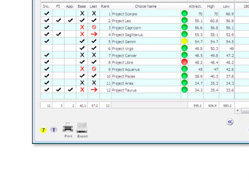
Step 2: Prioritize your projects by business value using the Optsee Prioritizer™
Instead of just ranking your projects using 1 or 2 models, you can get more robust and meaningful ranking by using the exclusive Optsee Prioritizer™. With just a few clicks, you can automatically test your projects in up to 100,000 different decision models. In seconds, your results are displayed in charts and forms that show you a clear statistical ranking by value to your business of all your choices. And you don't need to be a statistician to understand and present your analyses - custom Optsee® charts automatically display your results in a clear and comprehensible format.
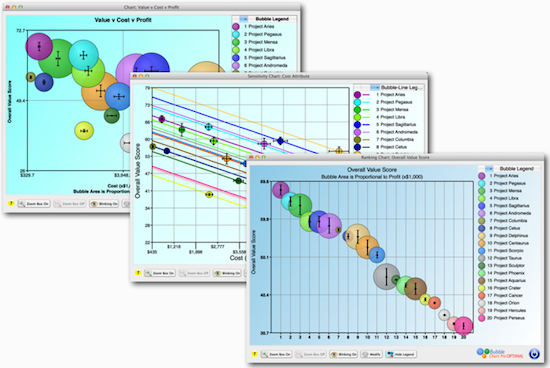
Step 3: Optimize against cost and resource constraints to select your best project set
Selecting the right set of projects to fund when you have multiple constraints is hard. Even with as few as 30 projects there are over 1 billion combinations of projects. How do you pick the best selection? It's easy using the Optsee Optimizer™. The Optsee Optimizer™ uses a proprietary algorithm to quickly and rigorously optimize your portfolio under multiple constraints, such as limited budgets, time, resources and project dependencies. You just select your constraints and click "Optimize". You can shift resources and costs and compare the results of different optimizations in the optimization comparison form, and you can also optimize to efficient frontiers to get the "biggest bang for your buck".
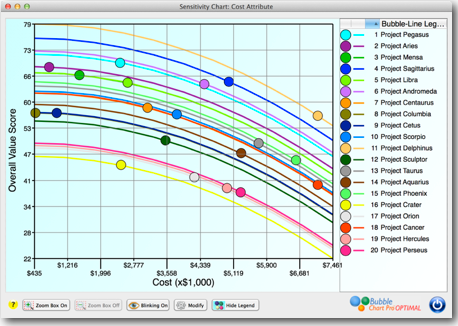
Step 4: Chart your portfolios and track your progress against baselines
Optsee® charts show you extremely insightful pictures of how your choices are distributed in your portfolios. Bubble and Uncertainty charts show you which choices are your best and why. Sensitivity charts help you predict the effects of changes in your choices or decision model. Optsee® has over 30 different chart-types built-in, so you can visualize and present your portfolio and model in many different ways.
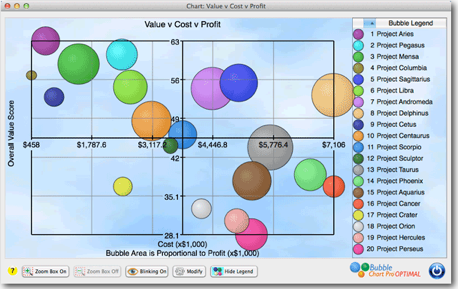
Optsee® Trend-Trackers allow you to track your projects and portfolios against multiple saved baselines so you can closely see how your projects and portfolios are doing over time. You can "drill-down" deeply into the trends to see at-a-glance changes at both the portfolio level as well as the individual attribute values at the project level.
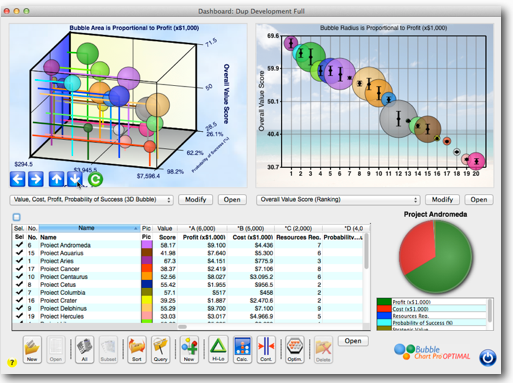
The Value Proposition
Customers will realize significant and measurable benefits and value from using Optsee® including:
- Increasing return on business investments by 15% or more
- Reducing the time required for budgeting and portfolio decisions by 50% or more
- Managing portfolio risk to achieve the right investment balance
- Objectively aligning and prioritizating budgets and portfolios with corporate vision, goals, and strategy
- Maintaining comprehensive metric-driven business cases for all projects or budget line items
- Quickly and flexibly re-balancing priorities in fast-changing fluid environments
- Have added adherence to mandated compliance and regulatory requirements such as Sarbanes-Oxley
Competitive Advantages
No other application currently marketed has this combination of features:
- Designed for non-IT centric parts of the enterprise
- Most powerful prioritization technology available off-the-shelf (proprietary design)
- Performs both prioritization and optimization in one integrated application
- Works with „real world“ data range estimates as well as single-point estimates
- Fast learning curve and no programming – designed for managers
- Export to and Import from Microsoft Excel®
- Custom charting built-in
- Track projects using baselines and dashboard-like color indicators
For more information, software purchases (rent or buy) and training contact Roland Gropp for EMEA Region and Russia.